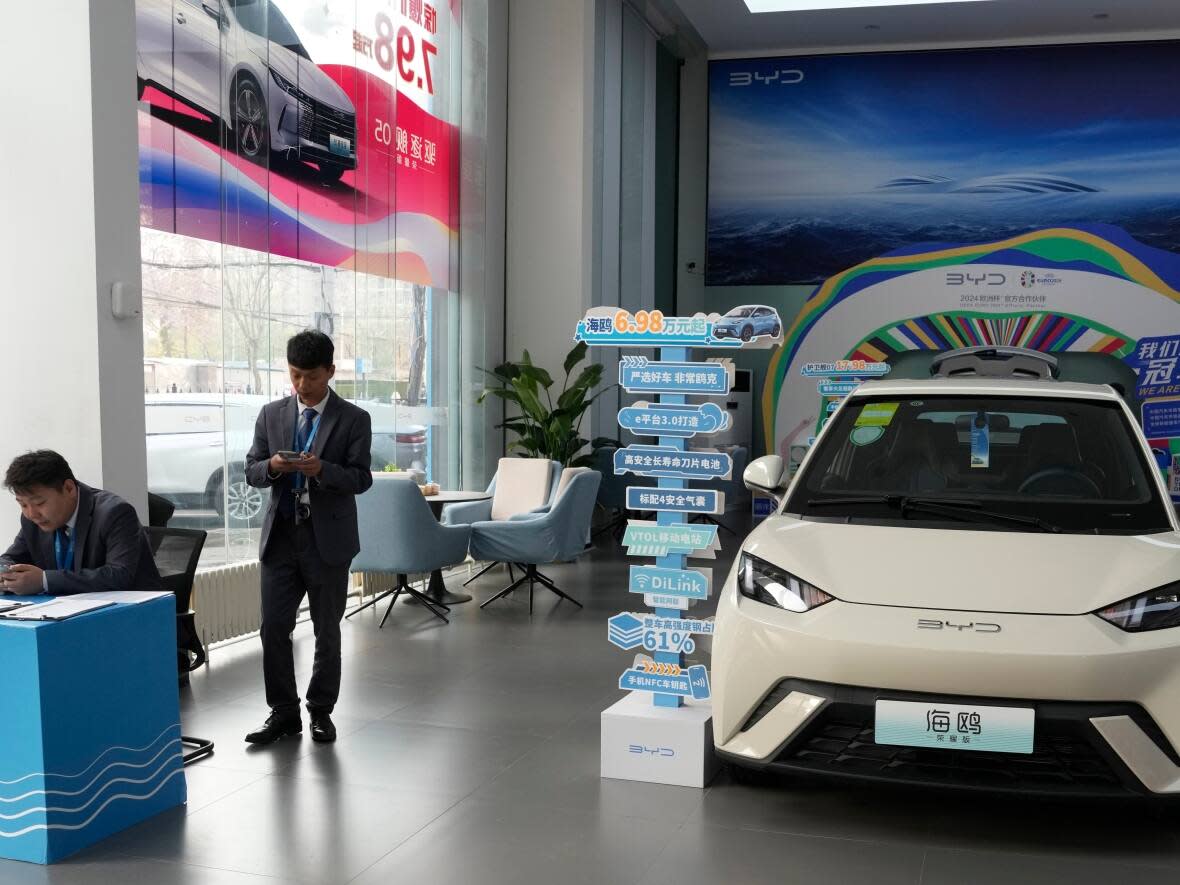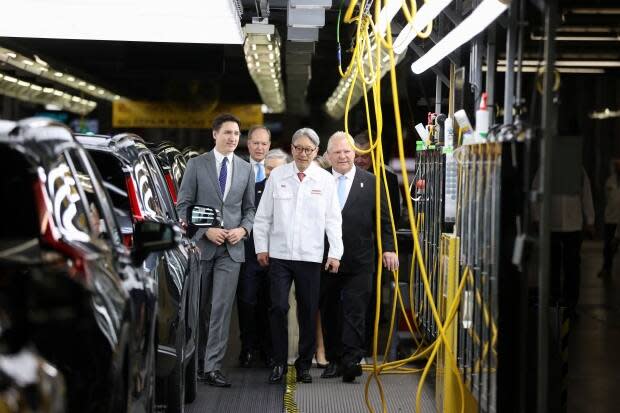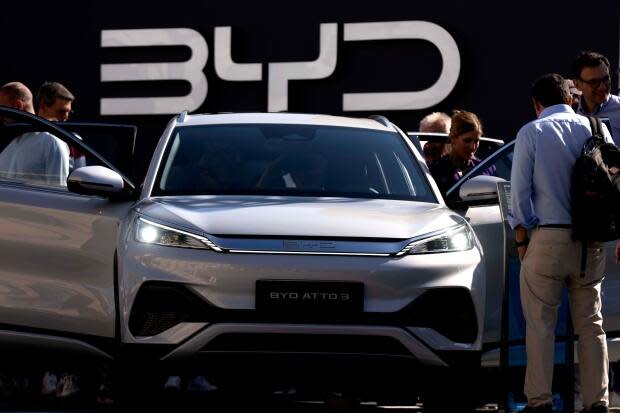China's EV market is going global. Can U.S., Canada balance protectionism with reducing emissions?

China's electric vehicle industry is poised to dominate the globe, and that has governments in Europe and North America, including Canada, grappling with how to meet ambitious targets for reaching 100 per cent zero-emission vehicle sales through domestic manufacturing.
"In the last five years or so, China emerged as an absolute leader in [the EV] space," said Alla Kolesnikova, head of data and analytics at Adamas Intelligence, a research and consulting firm specializing in strategic metals and minerals based in Toronto.
As a result, the U.S. has raised tariffs on EVs from China. The Canadian government is now exploring whether to follow suit.
Meanwhile, both countries have set aggressive goals for getting substantially more EVs on the road to reduce reliance on fossil fuels.
The federal government's electric vehicle sales mandate regulations include a national target of 100 per cent zero-emission vehicle sales in Canada by 2035. The U.S. is aiming to have between 35 per cent and 56 per cent of all vehicle sales between 2030 and 2032 be EVs.
WATCH | Innovation minster discusses options following U.S. tariff hike on Chinese EVs:
The problem, according to many analysts, is that both countries have a long way to go before their EV industries becoming self-sustaining.
Many industry watchers say it will take a lot of political will — and money — for Canada to develop its own industry and spur adoption without relying on Chinese car makers.
Barriers to EVs in Canada
According to Statistics Canada, zero-emission vehicles accounted for just over 10 per cent of all new motor vehicle registrations in 2023, an increase of 49.4 per cent from 2022.
However, moving past these early adopters will be a challenge, according to Niel Hiscox, president of Clarify Group Inc., a Canadian-based automotive research and advisory firm.
Hiscox says the higher upfront costs will mean a "a good chunk" of consumers will decide not to buy it. "You can't make the transition if the cars aren't there, if they're not affordable."
Commenting on the "chicken and egg" situation of building more capacity in Canada, Flavio Volpe, president of the Automotive Parts Manufacturers' Association told CBC's Metro Morning, as they build up capacity, prices should come down. As prices come down, more people will buy EVs and as they do, more charging stations will be built.
"If you agree that we're in a climate emergency, we need to do everything we can to encourage people to make a switch," said Cara Clairman, CEO of Plug n Drive, a non-profit committed to accelerating electric vehicle adoption in Canada.
Clairman says provinces like B.C. and Quebec have a higher adoption rate because of charging infrastructure, government subsidies and policies to encourage EV adoption.
Low cost, high quality in China

China's dominance can be attributed to a few factors, including the cheap cost of the vehicles and the fact there's a wide variety to choose from, according to Kolesnikova.
"There is an electric vehicle for any segment and any prospective buyer," she said. Those range from cheaper, smaller, more basic cars, to larger SUVs and luxury sedans.
In fact, the Seagull, a tiny electric car launched by Chinese automaker BYD (Build Your Dream) last year sells for as low as $10,000 US, or about $13,000 CAD, and it's just as robust as American cars, according to industry experts.
"It's low cost combined with high quality," said Chengyi Lin, professor of strategy at INSEAD Business School in Fontainebleau, France.
That cost is, in part, a result of government subsidies and an integrated supply chain, according to some analysts, as well as stiff competition from more than 100 companies who want a piece of the market.
That, and the fact that China mines an abundance of the metals and minerals needed for EV batteries, including lithium and cobalt, means they have the supply chain locked down, said Kolesnikova, who points out China is a major exporters of EV batteries, too.

"There's vertical integration for the companies there for sourcing battery metals and materials," she said.
Lin also credits charging infrastructure for China's quick adoption. According to the International Energy Agency, almost 60 per cent of all new electric car registrations were in China in 2023.
He said traditional office spaces or commercial spaces on the first floor of buildings are also being converted to charging stations, while taxi companies are re-vamping the drivers' shifts to accommodate range limitations.
"It's a whole ecosystem at play."
EV expansion, possible tariffs
Not for lack of trying, Canada has been trying to speed things up.
In mid-May, Prime Minister Justin Trudeau and Ontario Premier Doug Ford were among politicians in Port Colborne, Ont., announcing a new $1.6-billion EV battery plant thanks to an investment by Japanese company Asahi Kasei Corp and Honda.

In April, Honda announced a major expansion of its original Canadian facility in Alliston, Ont., to both manufacture batteries and assemble electric vehicle versions of its top-selling brands.
Considering China is also a major exporter of the materials to manufacture batteries, that's one industry where Canada needs to catch up, according to Sean De Vries, executive director of the non-profit Battery Metals Association of Canada.

"We have so many of those critical minerals [needed to make EV batteries] here," he said.
He applauds recent investments from the federal and provincial governments, but says they tend to be in component and battery manufacturing. He is hoping governments will put more money toward mining and mineral processing.
De Vries points out red tape is another impediment — it takes about 10 to15 years to approve a mine before shovels are in the ground.
"We need to speed up that process," he said.
Though there are currently no EVs made by Chinese automakers for sale in the U.S. or Canada yet (some models of Teslas and Polestar 2 made in China are available here, however), U.S. President Joe Biden announced a tax hike on imported Chinese EVs, among other products like advanced batteries and solar cells — from just under 30 per cent to more than 100 per cent.
In response, Canada's Industry Minister François-Philippe Champagne said Ottawa is "considering all measures."
"It's fair to say that everything is on the table to protect our industry and our workers," Champagne told CBC's Power and Politics last month.
In a separate interview, Volpe said "Canada has to" implement similar trade levies. "Now that the Americans have put up a tariff wall, we can't leave the side door open here,"
Competition drives change
But some critics, including environmental advocates, say levying our own tariffs may not be in Canada's best interest, especially if we are making a transition to clean energy.
"[The U.S. tariff hike] is primarily politically driven," said Nate Wallace, clean transportation program manager for advocacy group Environmental Defence.
"We need to be making clean technologies cheaper for consumers, not more expensive. Ultimately, hiking tariffs on EVs takes us in the wrong direction."

But as North America tries to ward off foreign cars and foster its own industry, it might not be long before more Chinese EVs are on the roads here.
"Immediately you won't see too many Chinese brands actively entering the U.S. and Canada," said Ron Zheng, an automotive business analyst with consulting firm Roland Berger, based in Shanghai. "But, they're all taking actions to get themselves prepared to enter the North American market with facilities in South America."
China has made major inroads in Latin America, including manufacturing plants in Brazil. BYD has also confirmed plans to set up shop in Mexico.
"Nobody wants to give up this large market in North America," said Zheng.
Even with 100 per cent tariffs like the U.S. announced, the cheapest Chinese EV would only cost roughly $20,000 USD.
The average price of a new vehicle in Canada is currently about $66,000, according to Canadian Black Book, which provides vehicle valuation data used by dealers. But an EV is close to $73,000.
Wallace says the answer isn't necessarily completely throwing open the doors to Chinese cars, but allowing more competition would ultimately drive prices down.
He points to Europe as an example, where automakers are racing to drop their prices in order to compete with Chinese vehicles there. (The European Commission is currently poised to announce tariffs.)
"Having more competition … will be more healthy for those automakers to actually drive that change," he said.

 Yahoo News
Yahoo News 
